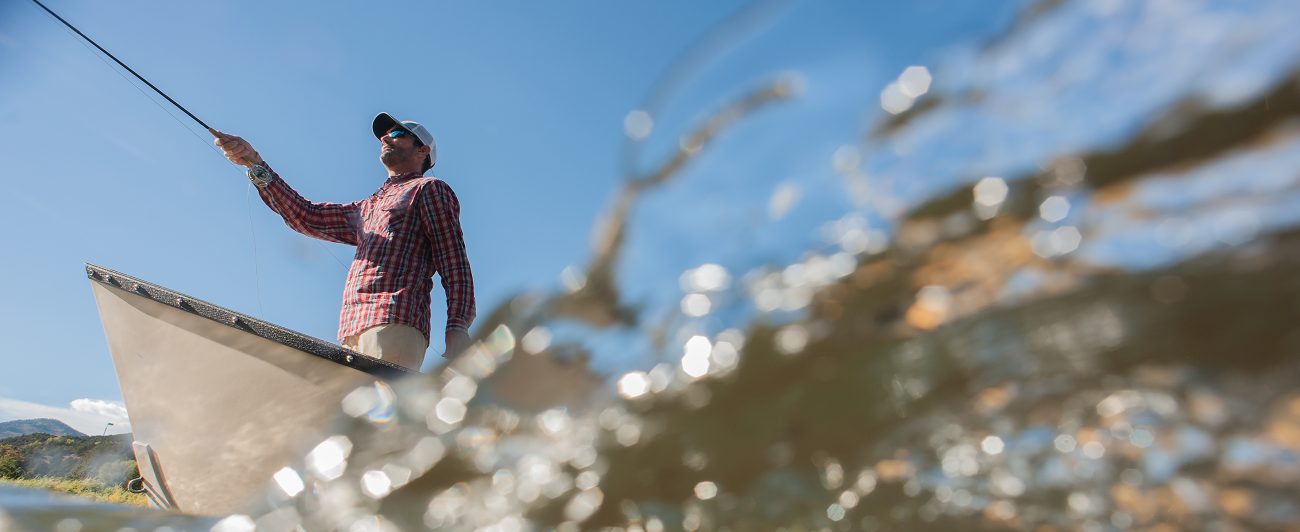Culture
Shakedown Cruise
ABOVE “Brad Befus decorates the bow during a day when it all seemed to come together on the upper Colorado River. We threw big dries, streamers, little dries, nymphs—everything worked and there was glory all around.” Photo: Tim Romano
It was a frigid morning on the upper Colorado River, with thick clouds piled up against the west slope of the Rockies and an icy fog over the water, sealing in the cold night air like a lid.
It was the last week in October, but everything about it felt like January. The big paved lot at the put-in had enough room for 40 trucks and trailers, but we were the only ones there. That meant we’d have this whole stretch of river to ourselves, but may also have meant we were the only ones dumb enough to want it. But never mind, Vince had been repairing and refinishing this wooden drift boat for most of the summer and was desperate to get it in the water at least once this season. So we wadered up, pulled the cover off the boat, left the use fee in the drop box, cash and keys in the truck for the shuttle driver and launched on an empty river.
This boat was built by Ray’s River Dories in Portland, OR in 1990, and although I’d never been in it before, I’d seen it around for years. At first it was owned by a friend who, like most fishermen with jobs, families and mortgages, used the boat as often as he could, but not as often as he’d have liked. Mostly it sat in the driveway while he was off running his landscaping business, lending an air of postponed adventure to a suburban neighborhood in Boulder, CO.
I’d always liked the looks of it. It’s a well-made and handsome Rogue River-style drift boat, but not in the ostentatious way of those that are intended to come off more like pieces of Chippendale furniture than fishing boats. By the time I first saw it, it already had the used but far from used-up look of an old and useful tool.
And it was nicely put together. The sides, seats and decks were made of Sapele African mahogany, the gunnels, chines, seats and stem post were Honduran mahogany and the boat frames and seats were Douglas fir. The wood inside was finished with oil and outside was painted a shade of green that reminded me of a John Deere tractor with a natural wood rub rail at the waterline. As drift boats go, it’s on the small side: 14-feet, 10-inches stem to stern (16 feet measured around the gunnels) with a 74-inch beam tapering to a bottom width of 48-inches. Viewed side-on, its lines were reminiscent of a floating leaf.
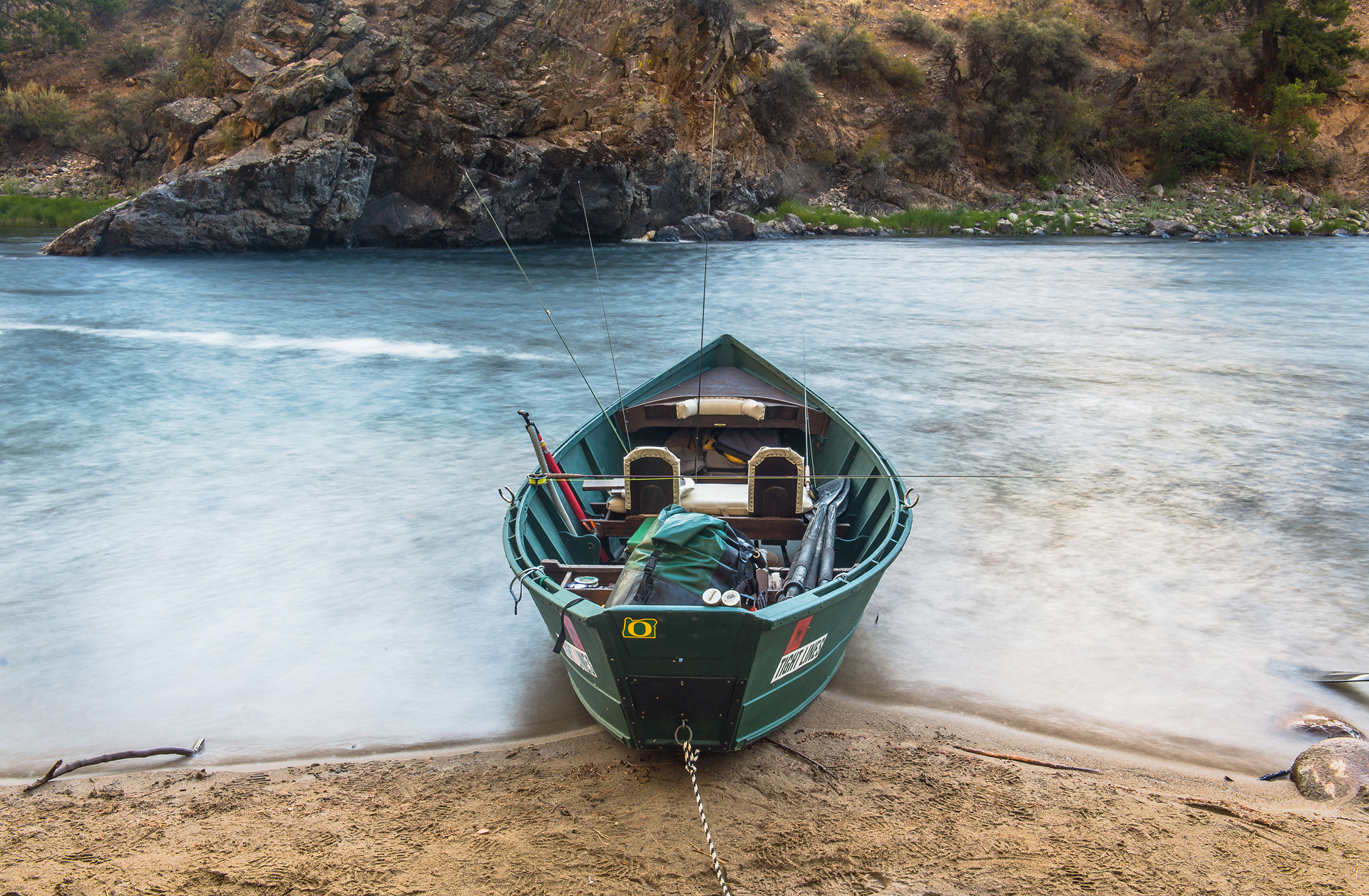
ABOVE “Fishing from Jeff Helfrich’s sweet wooden pony on Idaho’s Middle Fork of the Salmon River was trout fishing nirvana. If I can get him to ditch the horrible Oregon Ducks sticker he’ll have the perfect fishmobile.” Photo: Robert Dotson
Eventually, my friend Vince ended up owning it through a roundabout series of transactions. First he bought it for the kind of price he tends to get on things like this, which is more than fair, but somewhere short of outright theft. Then, just when I’d gotten used to it being parked in his driveway, he sold it for a profit without ever putting it in the water. And then, two years later, it reappeared; bought back at a bargain price as a fixer upper because by then it needed work the owner hadn’t gotten around to doing. He must have finally gotten tired of looking at it—or maybe of it seeming to look at him accusingly—and he just let it go. It was beginning to look like Vince was somehow meant to own this boat.
But it really did need work. By this time the casting brace and fly line deck were both cracked (no telling how that happened), the bottom was splintered near the stern where the anchor had been dropped unceremoniously or left to bounce around on a bumpy road, and the routine cleaning, sanding and refinishing were so long overdue that spots of ominous black mold had appeared on the deck. This is why wooden boats aren’t for everyone: If you put in the time and effort to take care of them, they’ll last for a hundred years, but if you treat them like they were unbreakable or blow off the maintenance, they’ll begin to delaminate.
Vince was just the guy to own a boat in this condition. He not only enjoys this kind of work but he also has the required skill as well as the kind of untroubled ego that lets him sniff out people who know more than he does for advice and then to take it. For instance, when he called the builder to ask about a replacement piece of mahogany for the fly deck, the man told him to just go to Home Depot and pick out a nice piece of birch plywood, which he did.
For months, every time I stopped at Vince’s house, he’d take me to the garage to show me what he’d recently done to the boat, or what he was planning to do next. Vince is no stranger to boats, but this was his first wooden one and by then he was reeling off the arcane nomenclature—inside chine log, swivel block, stem cap, sheer rail—and he was getting pretty attached to the craft. It was a bigger job than he’d anticipated, but wood is warm, friendly stuff to work with and all that fitting, sanding, gluing, brushing and rubbing on of oil is like stroking a large, docile animal—it engenders intimacy and affection and incidentally lowers blood pressure.
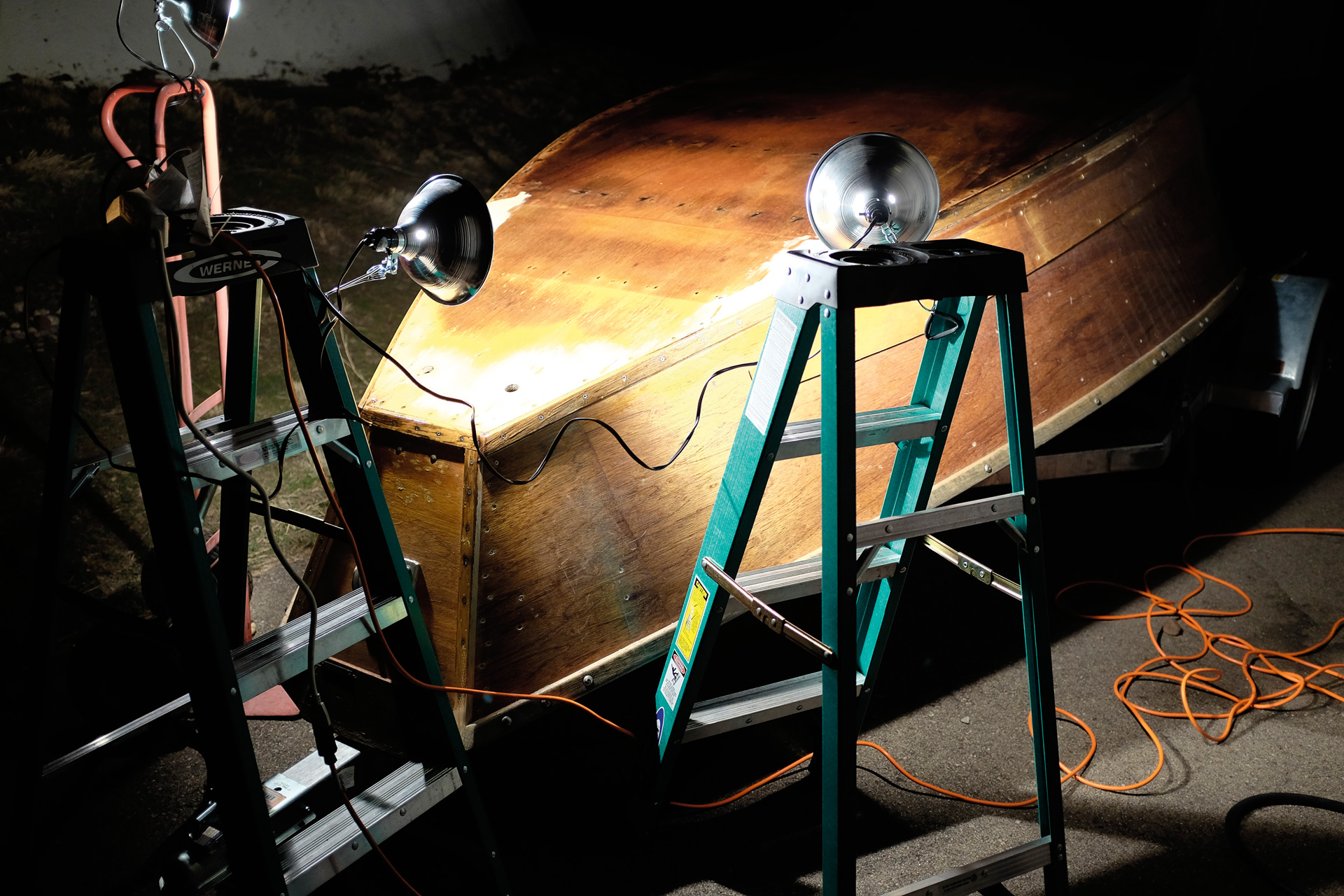
ABOVE “Finding indoor working space to do hull repairs on a 15-year-old wooden dory is a tall order if you don’t happen to actually own any indoor working space. If you do happen to find space there’s simply no telling how long the fix will take. A week? A month? A year? I’ll let you know….” Photo: Tim Romano
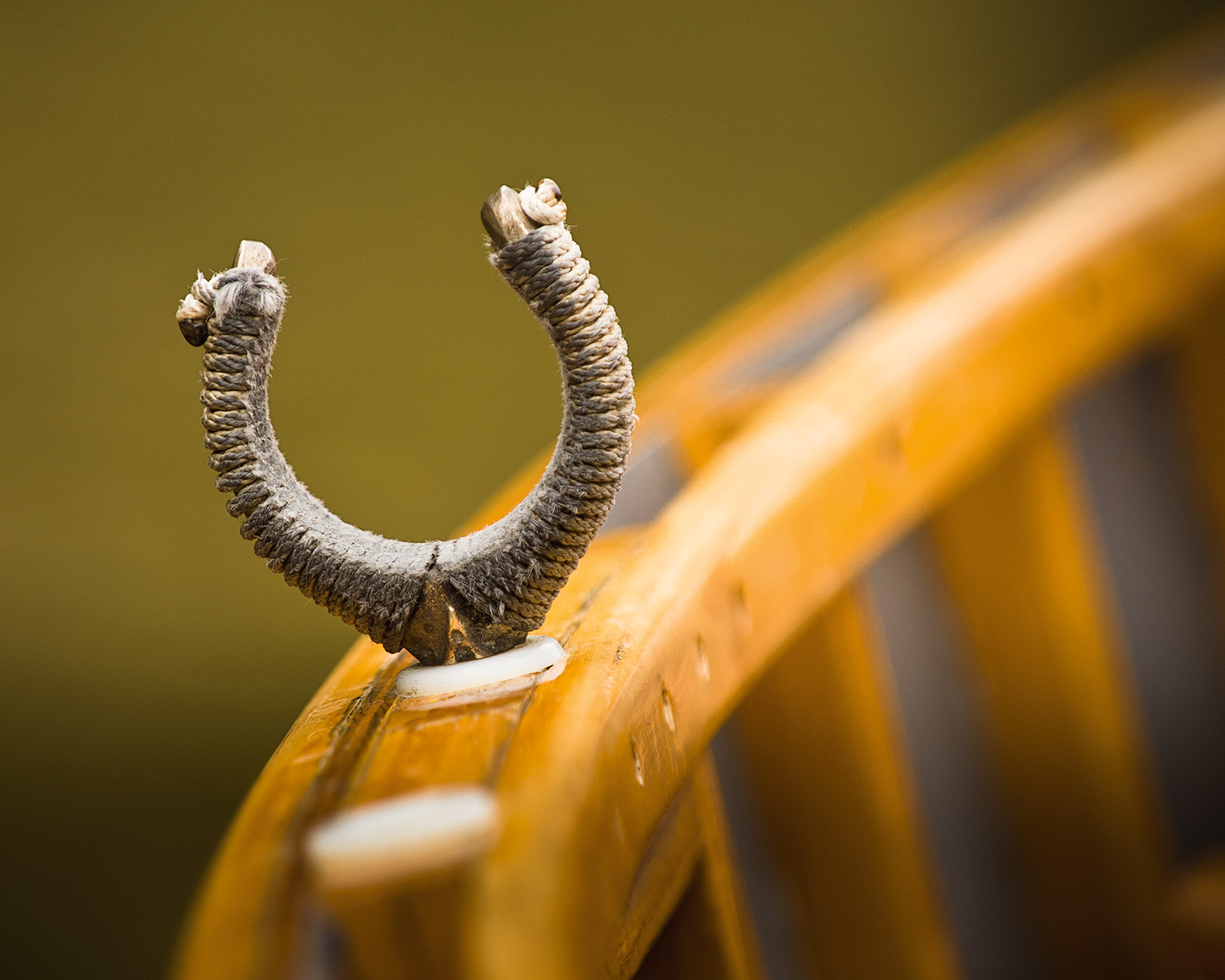
ABOVE A wooden boat is about craftsmanship, a deep appreciation for natural materials, the warmth of wood and hours of careful construction and care. Tight rope wraps add an understated touch of class to these brass oarlocks. Photo: Mark Lance
Naturally Vince took the oars that first day on the water. I automatically stood up in the bow with a streamer rod, but sat back down when I saw we’d be putting the boat through its paces. Vince rowed across the river and then back the other way, he draw-stroked first left and then right, tracked quietly in the main current for a minute—chopping the oars delicately—then spun the boat in mid-river and pulled smartly back upstream in a moderate current, the whole time wearing the discerning expression of a wine critic.
“It’s nice,” he said. “It handles nice; real light and responsive. In fact, it handles better than my old [fill in the blank with a well-known maker of fiberglass drift boats].”
Then he said, “OK,” and I stood back up and began working out line as we approached casting distance of the right bank.
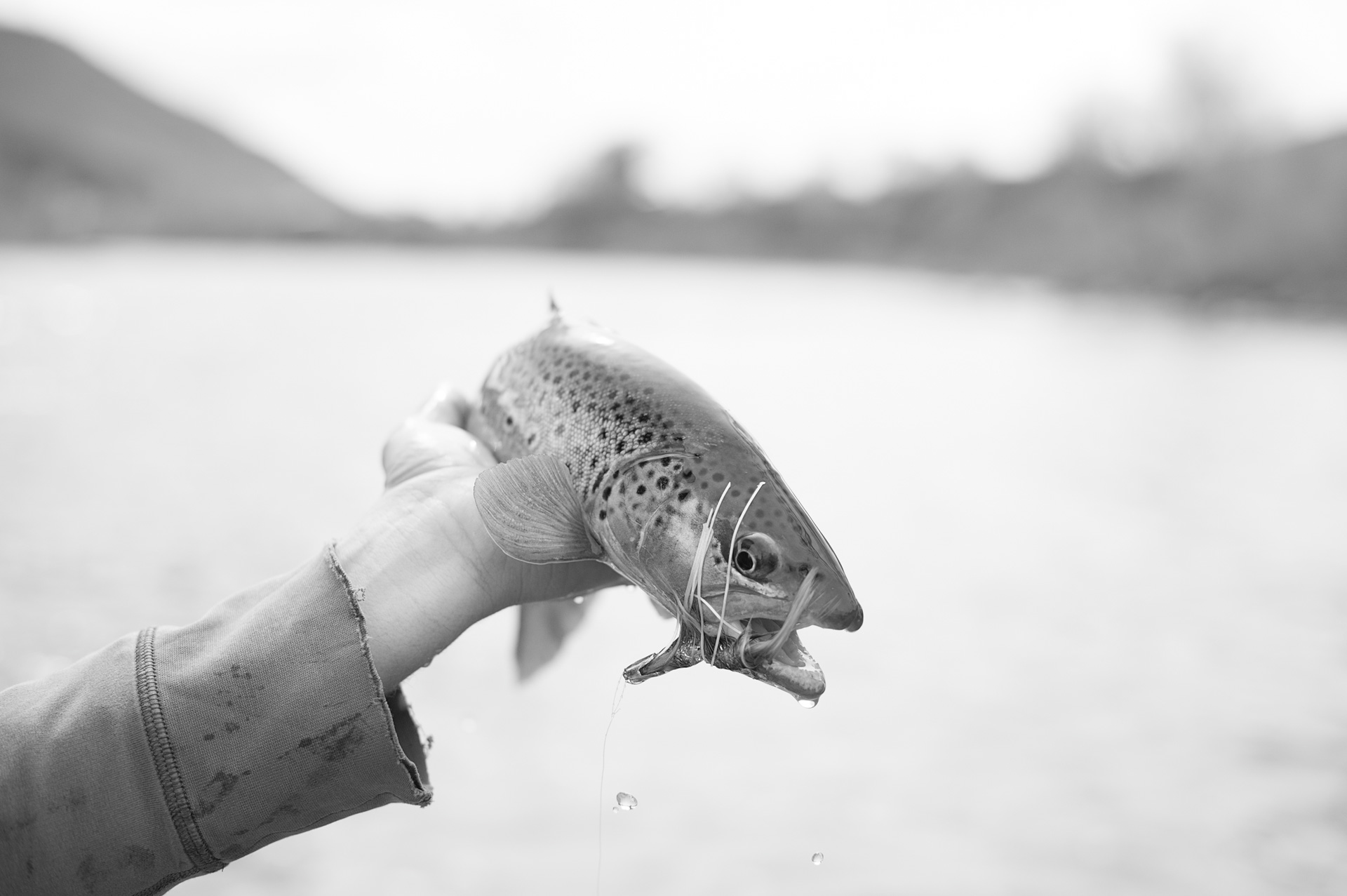
ABOVE Bob Stewart ties great flies and catches great fish with them. He tagged this drooling brown trout on the Colorado River downstream of Glenwood Springs on a warm overcast spring day—the type of day when you can find aggressive fish jump-starting their metabolism after a long winter. Photo: Copi Vojta
This was the kind of gloomy weather that can make for good fishing and we were on a stretch of river that’s known to hold lots of trout, but not many of them were interested in my streamer that day. The ones that were interested were holding tight and wouldn’t chase it more than two or three feet off the bank, so I was making long casts, a few short, quick strips and then picking up a lot of line for the next throw. About the time it occurred to me this would be easier if we were a little closer to the bank, the boat eased in a little closer to the bank as if I was controlling it telepathically. When you fish together long enough, this sort of thing happens so thoughtlessly you don’t have to ask and sometimes forget to say, “Thanks.”
The day could have gone either way. Up on the pass on the drive over that morning the sky was clear and the sun on the snow was as blinding as a spotlight, so there was the thought the clouds in the valley could burn off by early afternoon to produce one of those splendidly crisp, bright autumn days. But the two slopes of the Continental Divide can be like different planets, and instead the ceiling lowered and thickened, the air stayed dank and cold, and by midmorning a cold rain had begun—not quite sleet, but leaning in that direction and hinting it could turn to snow by dusk.
By the time a train passed on the tracks that share this valley with the river—slowing to walking speed as it rounded a tight curve 50 feet from the water—we were bundled in every stitch of warm clothes we’d brought, topped off with rain gear, hats with earflaps and fingerless gloves. In the popular vision of drift boats as seen on calendars and in magazine ads, they’re always out on sunny, windless days with snowcapped mountains in the middle distance and smiling fishermen in shirtsleeves, not in cold, gray drizzle with the mountains buried in clouds. We must have looked like discouraged gnomes to the passengers that gazed at us as blankly as TV watchers from their warm windows. We gazed back just as expressionlessly until one guy waved and we waved back. Once the train had passed, the river seemed even more vacant than it had before.
I took the oars after lunch and before we settled down to fishing I rowed around for a few minutes to get the feel of the boat. When I first rowed in current I made all the mistakes, digging the oars too deep, overcorrecting and most of all not reading the water right or thinking far enough ahead. I hadn’t yet learned to stop fighting the river and relax into it, so at the end of my first day I was exhausted. But eventually it became obvious that a drift boat is like a dry fly: If you put it in the right place upstream, it’ll drift to the right place downstream on its own with only minor adjustments for speed and angle, which involves less muscle than forethought. A good oarsman is like a pool player who not only makes the shot at hand, but also sets himself up for the next shot. Done right, it looks deceptively easy because most of the work is mental. I got some coaching along the way from guides and friends, but mostly I learned through the usual process of fucking up, remembering why and vowing not to do it again. Which is to say, I’m not a great boatman, but I manage.
At a bare minimum, you try to get down the river without hitting anything, but in the fullness of time bumps and scrapes are inevitable. This boat is equipped with a composite skid plate that makes scraping on shallow riffles less agonizing, and, like bamboo rods, wooden boats are tougher than you think, but it’s still possible to ding the chines, crack the hull or worse. It doesn’t help that this is the kind of pretty boat that people will walk over and admire, sometimes asking if you’re worried about putting it on the river. The answer is, “What else would I do with it?”
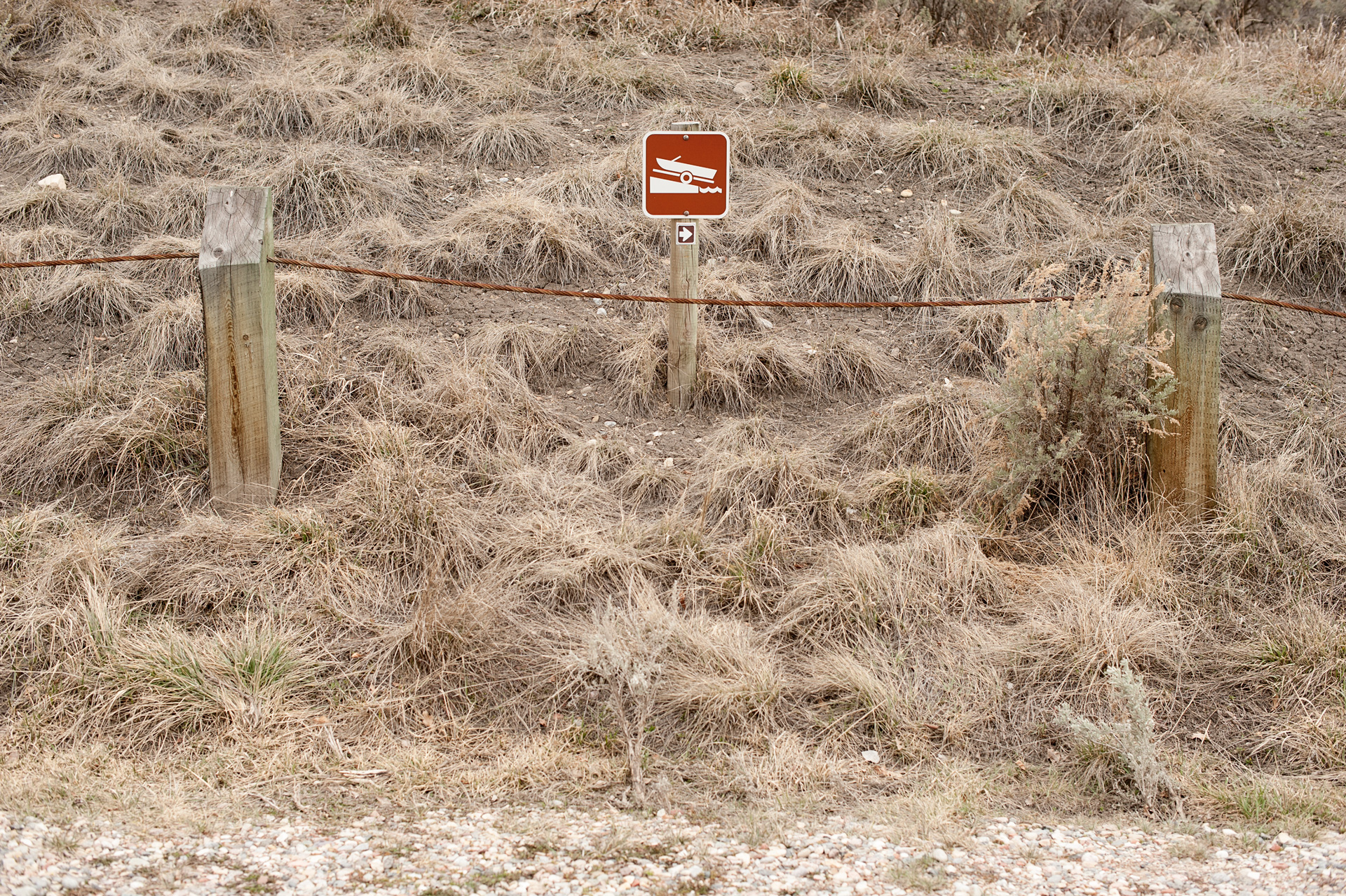
ABOVE The way to happiness is a bumpy path. A Bureau of Land Management boat-ramp sign directs traffic toward a launch along the upper Colorado River. Photo: Copi Vojta
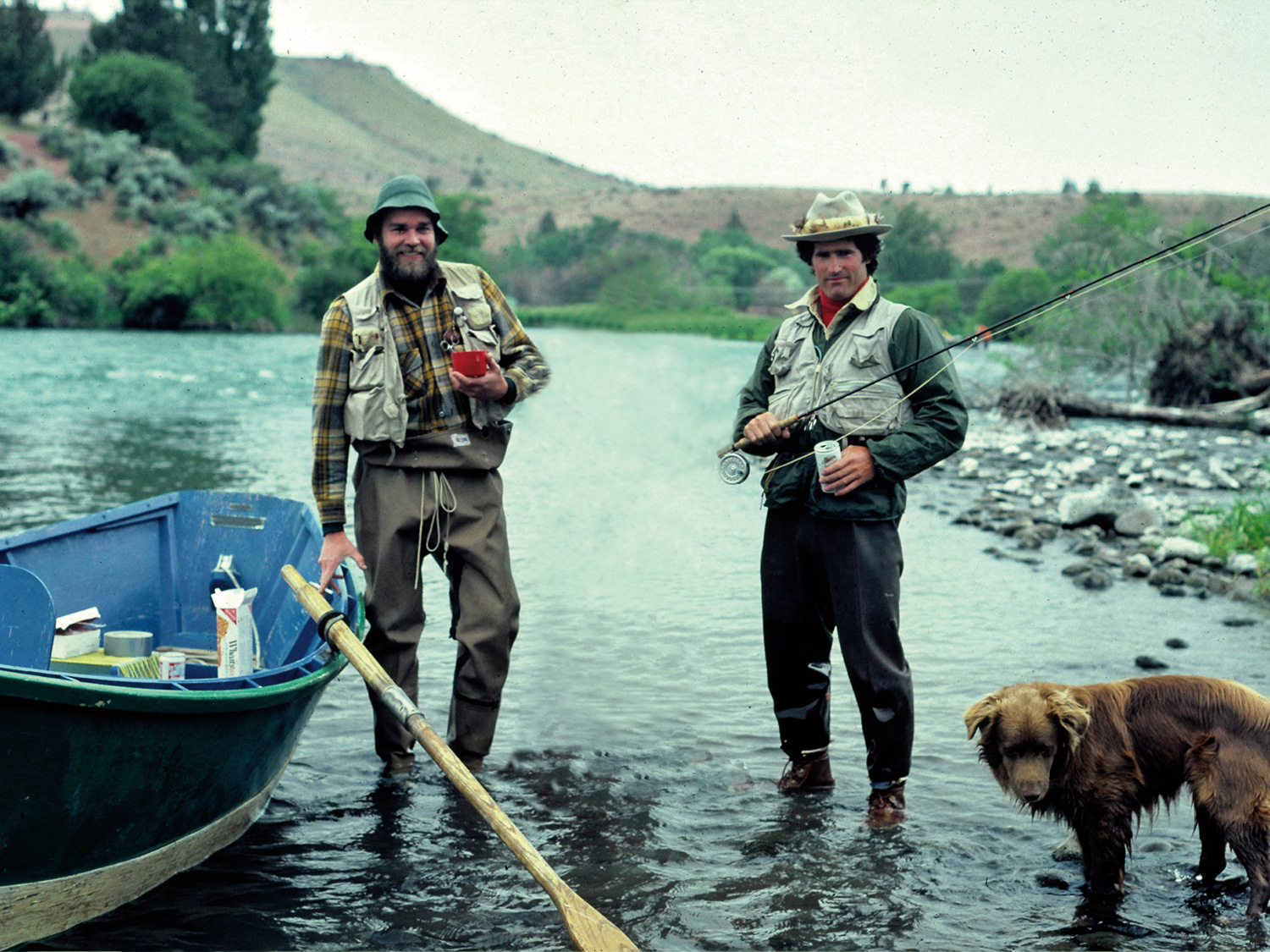
ABOVE “During the Deschutes River salmonfly hatch of June 1976, Dick Carter (left) and I floated from Warm Springs to Trout Creek. The fishing was so good that when we took our lunch break we had only floated one mile—there’s no fishing from the boat on the Deschutes—and had eight miles to go. Buddy, the Australian Shepard, was a fairly polite river dog, but on this trip he spent an hour chewing the cork off one of Dick’s Leonard bamboo rods.” Photo: Brian O’Keefe
Still, floating a river can be a distracting business with scenery, wildlife, drifting dry flies and fish to net all competing for your limited attention, but current is inexorable and a surprisingly short lapse in concentration can put you too far into trouble to get out gracefully. You’ll see drift boats with the motto “Fear No Rock” stenciled on them, which I always thought must be meant ironically, since an oarsman who truly fears no rock will sooner or later end up wet with all his expensive gear on the bottom of the river.
And, of course, it’s all in the service of the fisherman. The range, angle, and speed of the boat depend on the cast and drift that have to be made. Under ideal conditions, you arrange things so the best bank or seam passes right at your sport’s comfortable casting range, but conditions are rarely ideal, so you work out how best to split the difference. Like anything else, it can be done well, poorly or somewhere in between.
The boat rowed beautifully. It’s a foot shorter and 25 pounds lighter than the fiberglass dories we’re both used to, and its trimmer lines and higher rocker put proportionately less surface area in the water, so it’s noticeably quicker and more agile. And there’s an intuitive rightness about a boat made from a naturally buoyant material that just makes it seem livelier. It occurs to you not only that these drift boats derived from the original McKenzie River dories are the pinnacle of more than a century’s worth of thinking about rowing in current, but also that the boat in general was one of mankind’s great ideas.
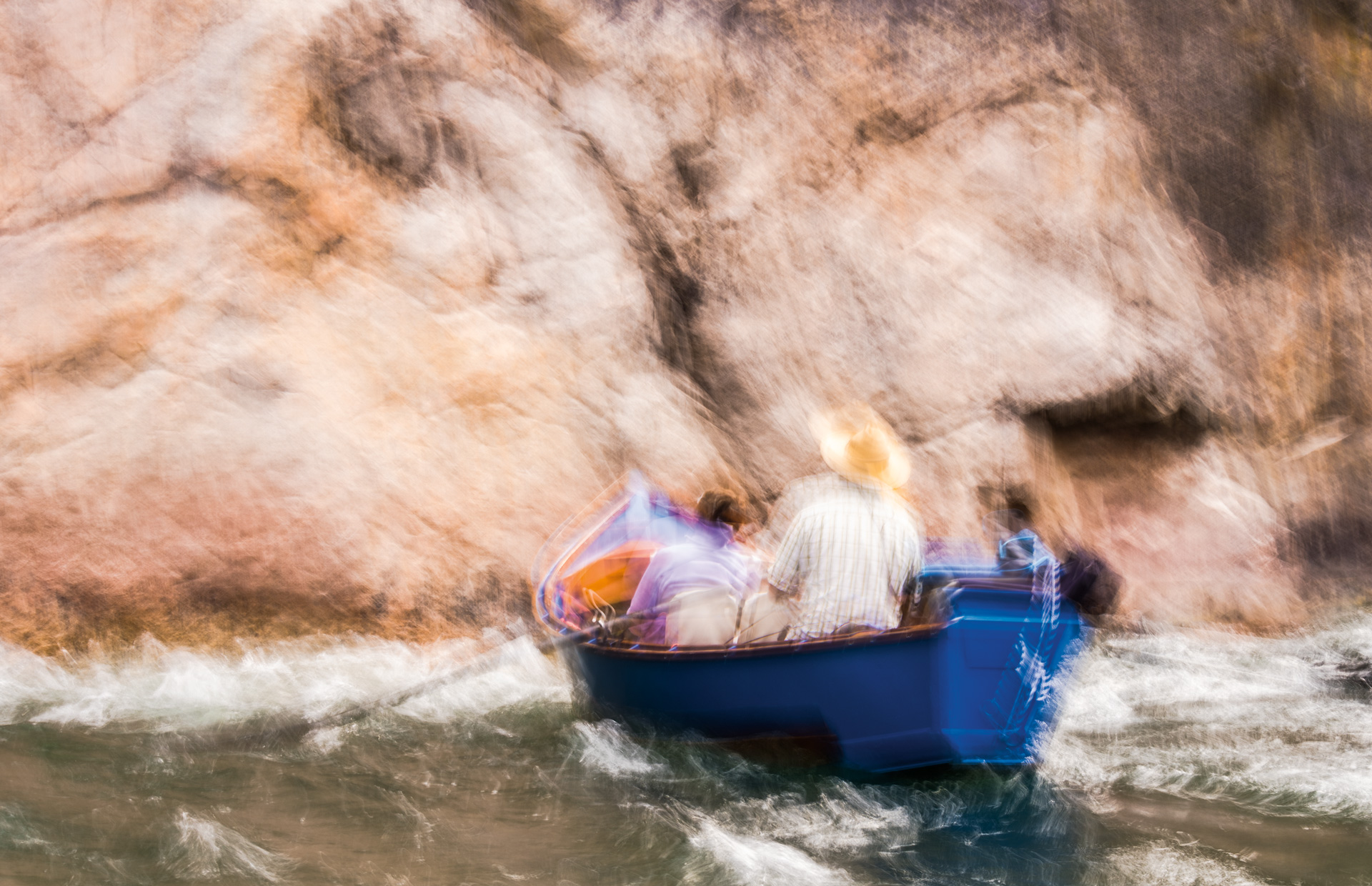
ABOVE Drifting the Middle Fork of Idaho’s Salmon River takes mad oar skills and plenty of guts. You know you’re alive—for the moment—when the Cliffside Rapids bring you face-to-face with a 1,500-foot granite wall. Trust brother, trust. Photo: Robert Dotson
Late in a float you sometimes begin to wonder about trusting your truck and trailer to an anonymous shuttle driver based on nothing but a phone call. Did he get sick or hungover and not show up? Did he have an accident or break down? Maybe some enterprising car thief understood that your truck parked at the put-in would be unlocked with the keys and some money hidden in one of the usual places and decided to steal it. For that matter, did you remember to tell the driver to leave it at the right takeout? It almost always works, but shit does happen, and if for some reason the shuttle didn’t get run, you’re in a world of hurt in the middle of nowhere.
Vince was back on the oars when we came in sight of the rusty iron bridge above the takeout. I reeled in and nipped off my fly as we bobbed down the choppy main current under the bridge and then tucked neatly into the eddy at the boat ramp on river right. And there was the familiar truck; the only one in the lot.
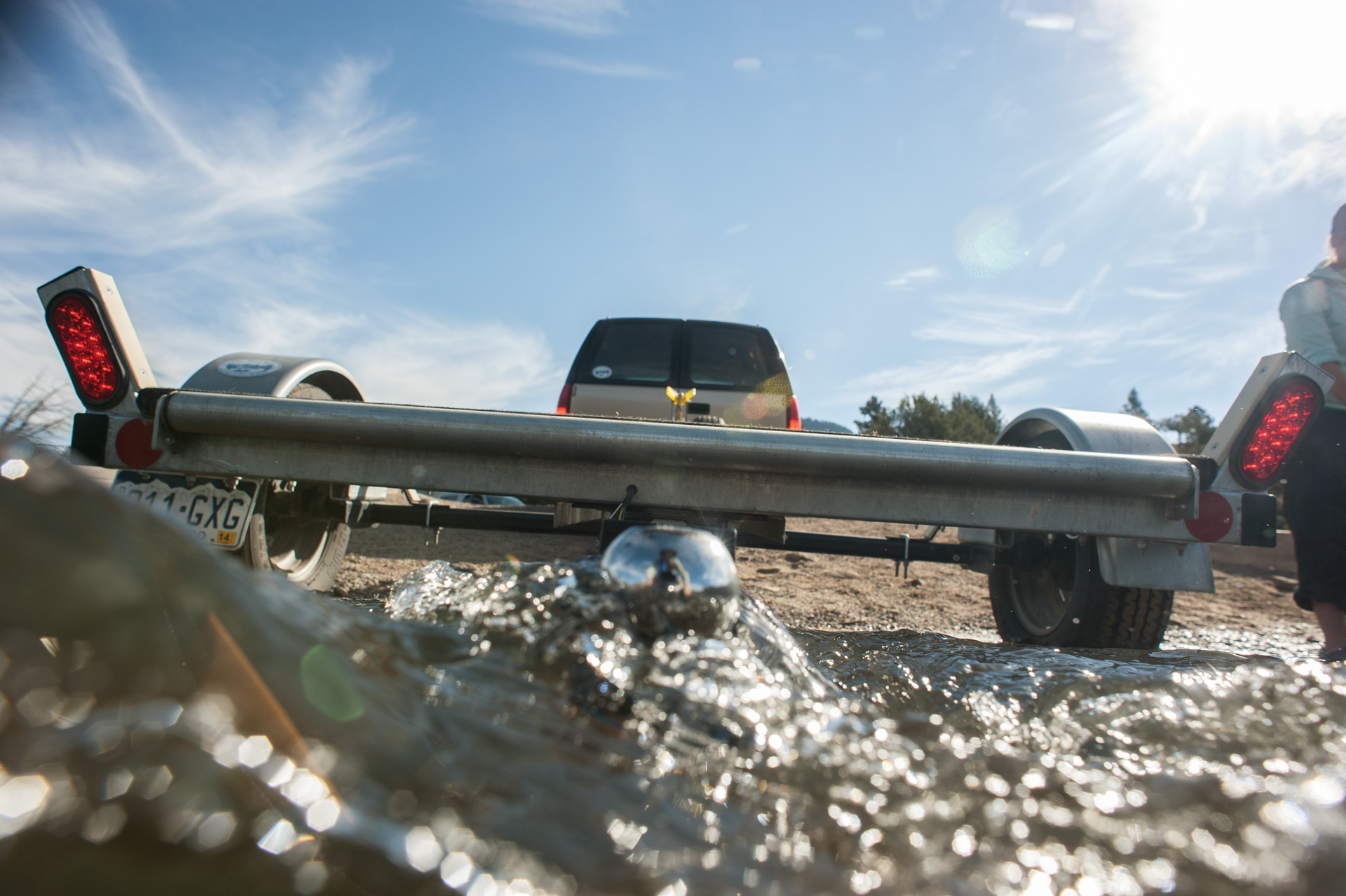
ABOVE “Please, God, tell me I didn’t forget the drain plug again.” Dropping in a dory at the Pumphouse launch on the upper Colorado River. Photo: Tim Romano
This story originally appeared in The Flyfish Journal Volume 8 Issue 2.
